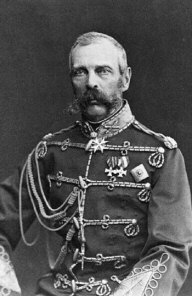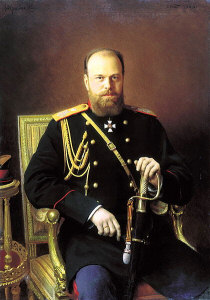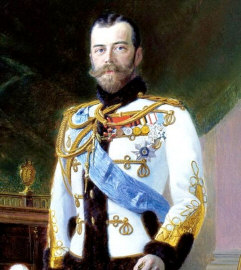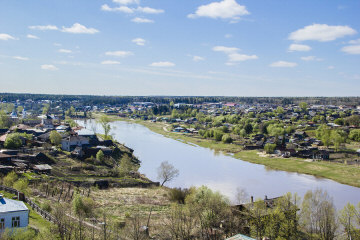The Fall of Tsarist Russia
Overview
Tsarism in Russia, developed throughout the 17th and 18th centuries, and was
characterized by a single leader’s despotic rule over the entire population. The
Tsar was a ruler who had absolute control over all issues. He was the final
authority on all matters, including the religious, and delegated power only to
those who would make decisions and carry out orders according to his wishes.
Tsarism was extremely popular among the majority of Russian individuals for many
years, and it was the members of the aristocracy, instead, who were blamed by
the public for Russia’s economic crisis.

The breakdown of this system was the result of many tensions that built up
over centuries and escalated in the final years of the autocratic government
system. Russia’s strict social hierarchy distinguished and ostracized the
working classes from the opulent aristocratic landowners that presided over them
and thus, produced a mass of impecunious individuals who had no means of
recovering from their penury. In order to preserve his volatile position as Tsar
Alexander II attempted minor reforms to the nation’s economy, social system as
well as the governmental structure. Despite the numerous improvements initiated
by Alexander II (such as the emancipation of the serfs in 1961), he was
assassinated and his son, Alexander III, assumed the role of Tsar as his
successor. The new tsar, Alexander III, was extremely reserved and disliked some
of the liberal decisions made by his father. Throughout his reign, he fought no
wars and was subsequently labeled “ The Peace-maker”. After his death in 1894,
his son Nicholas II ascended the throne of Russia as the final tsar of Russia.
The economic strain and the lack of support of the illiberal and monocratic
Tsarist regime led to many insurrectionist notions arising from the peasant and
urban working classes. This therefore contributed to the almost inexorable
downfall of the Tsar. The public discontent with both the employment, and living
conditions of the working class, as they endeavored to survive extreme poverty,
gave rise to many revolutionary ideas and led to subsequent rebellion.
The Tsars
Tsarist Russia was the only true autocracy remaining in Europe, during the time
just before the revolutions. The Tsar believed he had been chosen by God and was
not required to hold elections nor listen or heed the reeds or opinions of his
“subjects”.
Tsar Alexander II
|
Tsar Alexander II:

|
Despite the conventions of society and the severity of the political
despotism, Tsar Alexander II, under the pretense of altruism, approved many
reforms to improve the nation’s political, economical and social needs.
Alexander II desired some amelioration and positive reformation in order to
stabilize the nation’s unrest and, in 1861, he announced the passing of an
“Emancipation Manifesto” which suggested 17 judicial acts that would liberate
the Russian serfs. He declared that the maintaining of private serfs would be
prohibited and that all serfs would be permitted to purchase land from their
proprietors. In addition to this, Alexander introduced various local government
reforms in 1864, which were called a Zemstva. This Zemstva provided each district
with a council that possessed the authority to construct roads and schools and
supply medical services. The Tsar reformed the military, the previously
prevalent social hierarchy as well as both the political and educational
systems. Alexander’s focal motivations in modernizing the nation was to ensure
the preservation of the Tsarist autocracy but, as his reforms were not radical
enough, he was eventually assassinated by a fanatical insurrectionist group
entitled “People’s Will” on March 1, 1881; he was succeeded by his son Alexander
III. Thus, the reign of Alexander II provided the country with a renewed power
and prominence and is therefore a significant contribution to the strengths of
the Tsarist regime.
Tsar Alexander III
 In juxtaposition to his father’s reformist notions, the reign of Alexander III
marked a period of political and social repression in Russia as a reaction to
the witnessing of his father’s murder. Alexander III empowered and reorganized
the nation’s secret police into the severe and brutal Okhrana and positioned it
under the Ministry of Internal Affairs. This particular political office limited
the power of the Zemstva and the legislative power of the governing body, the
Duma. In order to protect the nation from what he considered to be the
detrimental impact of modernism, Alexander III placed strict value on the
oppression of all heterodox religions and non-Russian individuals. He also
repressed all forms of autonomy and extensively promoted anti-Semitism.
Alexander instated a policy of Russification in which all inhabitants of the nation,
regardless of their background, were expected to adhere to the conventions of
Russian society and begin to speak and act Russian. In blatant opposition to the
Tsar’s demands, many radical underground political organizations and movements
continued to develop. Alexander III died from liver disease on October 20, 1894
and was succeeded by his eldest son, Nicholas II. The severe repression that was
prevalent during the autarchy of Alexander III therefore increased the flaws
that were existent within the Russian Tsarist system. In juxtaposition to his father’s reformist notions, the reign of Alexander III
marked a period of political and social repression in Russia as a reaction to
the witnessing of his father’s murder. Alexander III empowered and reorganized
the nation’s secret police into the severe and brutal Okhrana and positioned it
under the Ministry of Internal Affairs. This particular political office limited
the power of the Zemstva and the legislative power of the governing body, the
Duma. In order to protect the nation from what he considered to be the
detrimental impact of modernism, Alexander III placed strict value on the
oppression of all heterodox religions and non-Russian individuals. He also
repressed all forms of autonomy and extensively promoted anti-Semitism.
Alexander instated a policy of Russification in which all inhabitants of the nation,
regardless of their background, were expected to adhere to the conventions of
Russian society and begin to speak and act Russian. In blatant opposition to the
Tsar’s demands, many radical underground political organizations and movements
continued to develop. Alexander III died from liver disease on October 20, 1894
and was succeeded by his eldest son, Nicholas II. The severe repression that was
prevalent during the autarchy of Alexander III therefore increased the flaws
that were existent within the Russian Tsarist system.
Effects of Nicholas II’s Poor Leadership on the Collapse of the Tsarist
Regime
 The autocratic reign of Tsar Nicholas II caused dissatisfaction within society
and feasibly provided numerous motives for the lower and working class Russians
to yearn for a more egalitarian political structure. Nicholas II was married to
Alexandra, a German princess who was the grand-daughter of Queen Victoria. She
was a traditionalist and an indefatigable defender of totalitarianism who
entreated her husband to defy all demands for governmental amelioration. Due to
his belief that a small victorious war would subdue the nation’s political
unrest as well as his desire to expand the Russian empire, Nicholas attacked the
Japanese empire. The Japanese eventually defeated Nicholas’ military reducing
the reputation of the Tsarist regime and sparking a number of reactionary groups
to evolve. Alexander’s unwillingness to modernize Russia and his attempts to
repress all seditious groups contributed to the many weaknesses of the Tsarist
system and ultimately led to the Russian Revolution that occurred later, in
1917. The autocratic reign of Tsar Nicholas II caused dissatisfaction within society
and feasibly provided numerous motives for the lower and working class Russians
to yearn for a more egalitarian political structure. Nicholas II was married to
Alexandra, a German princess who was the grand-daughter of Queen Victoria. She
was a traditionalist and an indefatigable defender of totalitarianism who
entreated her husband to defy all demands for governmental amelioration. Due to
his belief that a small victorious war would subdue the nation’s political
unrest as well as his desire to expand the Russian empire, Nicholas attacked the
Japanese empire. The Japanese eventually defeated Nicholas’ military reducing
the reputation of the Tsarist regime and sparking a number of reactionary groups
to evolve. Alexander’s unwillingness to modernize Russia and his attempts to
repress all seditious groups contributed to the many weaknesses of the Tsarist
system and ultimately led to the Russian Revolution that occurred later, in
1917.
The aristocracy, the traditional supporters of the Tsarist regime, began to
lose respect for the Tsar. Nicholas II’s ineptitude to govern the nation was
revealed in his association with Rasputin (an alleged “mystic” and the adviser
to Nicholas, who was unpopular with the public) as well as his violent decisions
concerning the nature of the suppression of the social unrest on Bloody Sunday
(January 1905) where soldiers fired at random into a crowd of peaceful
protesters. This display of poor leadership caused approximately 92 deaths and
resulted in the wounding of over one hundred people. Another demonstration of
defective leadership was his decision to disband the constitutional government
after the 1905 Revolution. The intelligentsia began to maintain that they could
no longer depend on the Tsar to heed their requirements and interests. The
realization of his inadequacy and the discontentment of the influential social
classes with the nation’s politics, was instrumental in creating the ultimate
doom of the Tsarist system.
In these ways, Nicholas’ reign as Tsar was doomed to a climacteric extent by
1914 due to social, economic and military reasons. The recognition of his
inadequacy to rule by the entirety of society and the loss of respect for him by
the influential classes significantly contributed to the eradication of the
dictatorial regime. Additionally, the appalling living and working conditions of
the urban workers as well as the penury of the peasantry ultimately resulted in
the formation of revolutionary groups that opposed the authoritarianism of the
Tsar. Further, despite the economic and agrarian reforms initiated by Witte and
Stolypin, WWI forced Russia into an economic recession with harsh food
shortages, social unrest and economic tension that eventually generated the
downfall of the Tsar’s draconian rule.
Impact of Socio-economic Antagonism on the Collapse of Tsarist Rule
 There was not enough fertile land to meet the demands of Russia’s growing
population. The majority of Russian land was inapposite for farming. During the
Tsarist rule, Russia was a predominantly agrarian nation and therefore, its lack
of adequate farming land was a significant strain on the economy. Russia was
extremely underdeveloped, using inefficient agriculture methods and were far
behind Britain, who had already undergone agricultural revolution a century
before. In a similar way, Russia was falling further behind other western
nations in terms of industry. It was in desperate need of industrialization and
modernization in order to gain more economic stability, generate the military
resources required to maintain Russia’s position as a major world power and
create employment for the surplus rural population. This, however, was
unfeasible with Russia’s flawed system of government. There was not enough fertile land to meet the demands of Russia’s growing
population. The majority of Russian land was inapposite for farming. During the
Tsarist rule, Russia was a predominantly agrarian nation and therefore, its lack
of adequate farming land was a significant strain on the economy. Russia was
extremely underdeveloped, using inefficient agriculture methods and were far
behind Britain, who had already undergone agricultural revolution a century
before. In a similar way, Russia was falling further behind other western
nations in terms of industry. It was in desperate need of industrialization and
modernization in order to gain more economic stability, generate the military
resources required to maintain Russia’s position as a major world power and
create employment for the surplus rural population. This, however, was
unfeasible with Russia’s flawed system of government.
The Effects of Russia’s Social Hierarchy on the Failure of Autocratic Rule
The uncompromising feudal system that was existent within Tsarist Russia was a
significant flaw that contributed to the many failings of the dictatorial
regime. Russia was governed by a single autocratic ruler who distributed power
among individuals of the aristocracy. Tsars would employ these landed patricians
to supervise the enforcement of laws and would also utilize the military to
forcefully subdue any rebellions or discontent with the totalitarian political
system. The aristocracy controlled approximately 50% of the nation’s capital but
was comprised of only 1% of the country’s population who dominated prominent
positions within the military and government. The other classes within the
system were excluded from politics due to their social status and lack of
education.
Additionally, the bourgeoisie were small in number and, despite their
relative affluence and standard of living, they had no influence on the nation’s
government. Many were dissatisfied with their exclusion from affairs of state
and, thus, sought after a more progressive and liberal Russia. In conjunction
with this, the urban workers made up about 10% of the Russian population. They
were moderately educated and were concentrated in the larger, more industrial
cities where they were influenced by many radical, insurrectionist notions of an
egalitarian society. The serfs or peasantry were subsistence farmers and
comprised over 80% of the nation’s population. They had egregious living and
working conditions and were over-taxed at an rate which made it virtually
impossible to pay taxes.
The strict hierarchical structure caused a significant amount of unrest
within the lower, repressed classes whose autonomy and political rights were
unrecognized. The preponderance of the Russian populace were dissatisfied with
their exclusion from affairs of state and, thus, sought after a more progressive
and liberal Russia. The primitive feudalistic system that subsisted within
Tsarist Russia was therefore a crucial foible that was instrumental in adding to
the abundant imperfections of the oppressive dictatorial system of government.
Effects of the economic strain caused by WWI
 The social and economic tension originating from the first World War caused the
downfall of the Tsar to a momentous extent. The socially unpopular war revealed
the egotism and expertness of the upper echelons of society as well as the
amoral military leadership. The incompetent training of the soldiers resulted in
substandard leadership and a military that was unprepared for modern warfare.
The war also produced mass food shortages, economic strain and formal social
recognition of the inadequacy of the Tsar and the military leadership. The
result of this, as well as the loss of morale that occurred due to a monumental
defeat by Germany in the Battle of Tannenberg in August 1914. The social and economic tension originating from the first World War caused the
downfall of the Tsar to a momentous extent. The socially unpopular war revealed
the egotism and expertness of the upper echelons of society as well as the
amoral military leadership. The incompetent training of the soldiers resulted in
substandard leadership and a military that was unprepared for modern warfare.
The war also produced mass food shortages, economic strain and formal social
recognition of the inadequacy of the Tsar and the military leadership. The
result of this, as well as the loss of morale that occurred due to a monumental
defeat by Germany in the Battle of Tannenberg in August 1914.
Reforms of Stolypin and Witte
Alternatively, the reforms of Pyotr Stolypin and Sergei Witte could
potentially have preserved Nicholas’ autarchic regime until their replacement by a
series of nonentities whose single policy was that of repression.
 Sergei Witte was the Finance Minister from 1892 until 1903. Witte’s
objective, to maintain the existing Tsarist despotism, was attempted to be
reached by means of modernization. He desired to modernize the Russian economy
to equal the degree of industrialization of the Western nations. In order to
achieve this, he invited many foreign, skilled workers to Russia to advance the
entirety of its financial, social and military systems. Witte also initiated the
extension of the railways and directed the construction of the prominent
Trans-Siberian Railway. Despite these positive reforms, Witte’s policies relied
heavily on foreign loans and investments and did not heed the agrarian needs of
the peasantry. This ephemeral higher standard of living created by Witte’s
advancements as well as the period of brief economic boom eventually resulted in
a recession which caused significant dissatisfaction within the urban working
class. Further, the worldwide economic crisis meant that there was no market for
Russian industrial goods and led to further unemployment. Following this, the
poor harvests in 1900 and 1902 caused extreme dissatisfaction amongst the
workers. Sergei Witte was the Finance Minister from 1892 until 1903. Witte’s
objective, to maintain the existing Tsarist despotism, was attempted to be
reached by means of modernization. He desired to modernize the Russian economy
to equal the degree of industrialization of the Western nations. In order to
achieve this, he invited many foreign, skilled workers to Russia to advance the
entirety of its financial, social and military systems. Witte also initiated the
extension of the railways and directed the construction of the prominent
Trans-Siberian Railway. Despite these positive reforms, Witte’s policies relied
heavily on foreign loans and investments and did not heed the agrarian needs of
the peasantry. This ephemeral higher standard of living created by Witte’s
advancements as well as the period of brief economic boom eventually resulted in
a recession which caused significant dissatisfaction within the urban working
class. Further, the worldwide economic crisis meant that there was no market for
Russian industrial goods and led to further unemployment. Following this, the
poor harvests in 1900 and 1902 caused extreme dissatisfaction amongst the
workers.
Pyotr Stolypin was made Prime Minister by Tsar Nicholas II in 1906. He held
the belief that action needed to be taken in order to stabilize Tsarism, in the
years subsequent to the 1905 revolution. He desired to provide universal
education in Russia by 1922 and to clamp down on insurrectionists. In 1906, 21,000 individuals were exiled and 1008 were executed by hanging;
the noose began to be referred to as “Stolypin’s necktie.” Stolypin’s reforms included the
introduction of a Duma, a legislative body elected by a select group of
individuals and the modernization of agriculture by dissolving the mir system of
farming and passing land from communal holding to individual possession. He was
assassinated by a Social Revolutionary in 1911, therefore eliminating the last
probable savior of the Tsarist system.
Although some reforms and rulers that were in place during the Tsarist regime
in Russia were positive, many had a detrimental impact upon Russian society,
economy and eventually, the Tsars themselves. The flaws that were prevalent
within the Tsars’ system of despotism were the origin of the disintegration of
the existing social structure, the widespread discontent with the system of
government and the declining economy of the nation. The severe feudalistic
hierarchy, the penury of the serfs and lower classes and the social and
political repression strongly overpower the minor reforms instituted by
Alexander II and led to the ultimate downfall of Tsarism in Russia.
Politics
The Fall of Tsarist Russia |